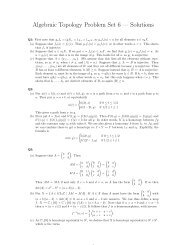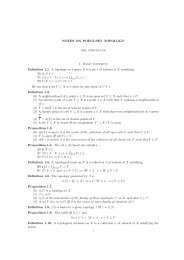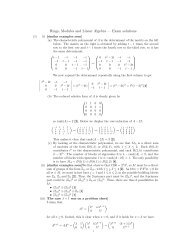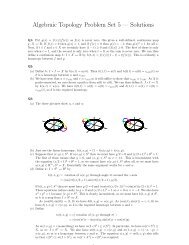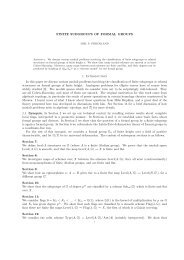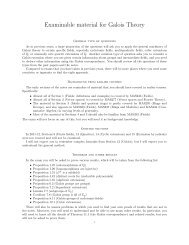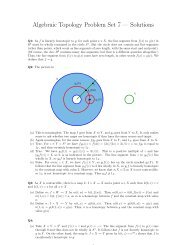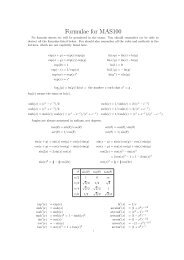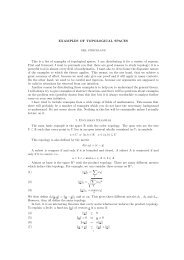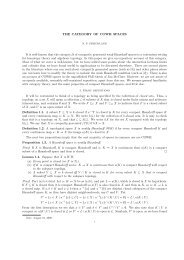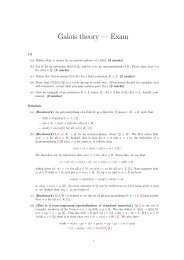TOPOLOGY PROBLEMS (1) State the Arzela-Ascoli ... - Neil Strickland
TOPOLOGY PROBLEMS (1) State the Arzela-Ascoli ... - Neil Strickland
TOPOLOGY PROBLEMS (1) State the Arzela-Ascoli ... - Neil Strickland
Create successful ePaper yourself
Turn your PDF publications into a flip-book with our unique Google optimized e-Paper software.
<strong>TOPOLOGY</strong> <strong>PROBLEMS</strong> 9<br />
Now suppose X is a metric space (we shall use <strong>the</strong> same symbol d for all metrics).<br />
Define <strong>the</strong> ɛ-oscillation of u as<br />
osc ɛ (u) = sup{|u(x) − u(y)| | d(x, y) < ɛ}<br />
Give a clean proof that osc ɛ : C(X) −→ R is continuous.<br />
This shows that <strong>the</strong> set<br />
U(ɛ, δ) = {u | osc ɛ (u) < δ}<br />
is open. Prove that for fixed δ, we have<br />
⋃<br />
U(ɛ, δ) = C(X)<br />
ɛ>0<br />
These are <strong>the</strong> first steps in <strong>the</strong> proof of <strong>the</strong> following uniform Fourier approximation<br />
<strong>the</strong>orem. Let P be <strong>the</strong> space of functions u: [−π, π] −→ R given by a finite Fourier series:<br />
n∑<br />
u(x) = a k cos(kx) + b k sin(kx)<br />
k=0<br />
Then, given δ > 0 <strong>the</strong>re is a continuous map<br />
F : C[−π, π] −→ P<br />
such that d(u, F (u)) < δ for all u. Of course, F is something like <strong>the</strong> Fourier transform,<br />
but we have to work out how to fix it up so that we take different but finite numbers of<br />
terms for different functions u, and have <strong>the</strong> result depending continuously on u.<br />
(6) (a) Let p be a prime number, and consider <strong>the</strong> space Z with <strong>the</strong> p-adic metric:<br />
v(n) = max{k | n is divisible by p k }<br />
|n| = p −v(n)<br />
d(n, m) = |n − m|<br />
The exceptional cases are: v(0) = ∞, |0| = d(n, n) = 0. Let Z p be <strong>the</strong> completion of<br />
Z with this metric.<br />
Prove that Z p is compact and Hausdorff.<br />
(b) For each k ∈ N, define a relation ∼ k on Z by<br />
n ∼ k m iff v(n − m) ≥ k<br />
Prove that this is an equivalence relation. Write Z/p k for Z/ ∼ k and [n] k for <strong>the</strong><br />
∼ k -equivalence class of n. Prove that Z/p k is finite and discrete in <strong>the</strong> quotient<br />
topology.<br />
(c) Prove that <strong>the</strong> map<br />
r k : Z/p k −→ Z/p k−1<br />
r k ([n] k ) = [n] k−1<br />
is well-defined (explain what might be a problem and why it isn’t).<br />
(d) Consider <strong>the</strong> space<br />
X = {a | ∀k > 0<br />
r k (a k ) = a k−1 } ⊂ ∏ k∈N<br />
Z/p k<br />
Prove that X is compact and Hausdorff. It is possible to prove compactness directly,<br />
but I recommend <strong>the</strong> use of general <strong>the</strong>orems instead.<br />
(e) For each k ∈ N and c ∈ Z/p k consider <strong>the</strong> set<br />
U k (c) = π −1<br />
k {c} ∩ X = {a ∈ X | a k = c}<br />
Show that <strong>the</strong> sets U k (c) form a basis for <strong>the</strong> topology on X.




